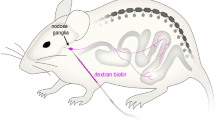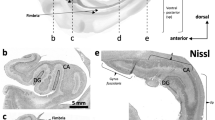Abstract
Neural cell adhesion molecules (NCAMs) can undergo post-translational modifications, such as the addition of polysialic acid chains, thus generating PSANCAMs, which are expressed mainly during development. Since polysialylation considerably modifies NCAM adhesivity, expression of NCAMs and PSANCAMs has been investigated in the developing hypophysis by immunohistochemistry. At embryonic day 13 (E13), an antibody against NCAM outlined all cellular profiles in the entire Rathke's pouch; this labelling persisted until adulthood. NCAM expression increased in all lobes during development and concerned all pituitary cell types. In contrast, at E13, PSA-NCAMs were only detected in the neural lobe, solely constituted of pituicytes at this stage, and the tuberal lobe, the only lobe expressing hormonal mRNA at the same stage. PSA-NCAMs expression increased in the neural lobe at E17 with the arrival of the neurosecretory fibres and persisted into adulthood. In the anterior lobe, PSA-NCAMs appeared at E15 where their distribution was similar to that of the differentiating corticotrophic cells; at subsequent stages, their expression extended to the whole anterior lobe. Only two cell types, corticotrophic and somatotrophic cells, remained labelled in the adult gland. In the intermediate lobe, melanotrophic cells never expressed PSA-NCAMs but these were expressed on folliculo-stellate cells at birth, preceding the onset of innervation. These results suggest that NCAMs and PSA-NCAMs play a role in pituitary histogenesis, cell differentiation and neurointermediate lobe innervation.
Similar content being viewed by others
References
Björklund A, Falck B, Hromek F, Owman C, West KA (1970) Identification and terminal distribution of the tubero-hypophyseal monoamine fibre systems in the rat by means of stereotaxic and microspectrofluorimetric techniques. Brain Res 17:1–23
Bonfanti L, Olive S, Poulain DA, Theodosis DT (1992) Mapping of the distribution of polysialylated neural cell adhesion molecule throughout the central nervous system of the adult rat —an immunohistochemical study. Neuroscience 49:419–436
Cunningham BA, Hemperly JJ, Murray BA, Prediger EA, Brackenbury R, Edelman GM (1987) Neural cell adhesion molecule: structure, immunoglobulin-like domains, and alternative RNA splicing. Science 236:799–806
Davis MD, Lichtensteiger W, Schlumpf M, Bruinink A (1983) Early postnatal development of pituitary intermediate lobe control in the rat by dopamine neurons. Neuroendocrinology 39:1–12
Grant NJ, Léon C, Aunis D, Langley K (1992) Cellular localization of the neural cell adhesion molecule L1 in adult rat neuroendocrine and endocrine tissues: comparisons with NCAM. J Comp Neurol 325:548–558
Hall H, Liu L, Schachner M, Schmitz B (1993) The L2/HNK-1 carbohydrate mediates adhesion of neural cells to laminin. Eur J Neurosci 5:34–42
Hindelang C, Félix JM, Laurent FM, Klein MJ, Stoeckel ME (1990) Ontogenesis of POMC gene expression and regulation in the rat pituitary intermediate lobe. Cell Mol Endocrinol 70:225–235
Horstkorte R, Schachner M, Magyar JP, Vorherr T, Schmitz B (1993) The 4th immunoglobulin-like domain of NCAM contains a carbohydrate recognition domain for oligomannosidic glycans implicated in association with L1 and neurite out-growth. J Cell Biol 121:1409–1421
Kiss JZ, Wang C, Rougon G (1993) Nerve-dependent expression of high polysialic acid neural cell adhesion molecule in neurohypophyseal astrocytes of adult rats. Neuroscience 53:213–221
Langley OK, Aletsee-Ufrecht MC, Grant NJ, Gratzl M (1989) Expression of the neural cell adhesion molecule NCAM in endocrine cells. J Histochem Cytochem 37:781–791
Le Gal La Salle G, Rougon G, Valin A (1992) The embryonic form of neural cell surface molecule (E-NCAM) in the rat hippocampus and its reexpression on glial cells following kainic acid-induced status epilepticus. J Neurosci 12:872–882
Léon C, Grant NJ, Aunis D, Langley K (1992) L1 cell adhesion molecule is expressed by noradrenergic but not adrenergic chromaffin cells: a possible role for L1 in adrenal medullary design. Eur J Neurosci 4:201–209
McBurney RN, Kehl SJ (1988) Electrophysiology of neurosecretory cells from the pituitary intermediate lobe. J Exp Biol 139:317–328
Nemeskéri A, Sétáló G, Halász B (1988) Ontogenesis of the three parts of the fetal rat adenohypophysis. Neuroendocrinology 48:534–5432
Pollerberg GE, Beck-Sickinger A (1993) A functional role for the middle extracellular region of the neural cell adhesion molecule (NCAM) in axonal fasciculation and orientation. Dev Biol 156:324–340
Rougon G, Dubois C, Buckley N, Magnani JL, Zollinger W (1986) A monoclonal antibody against Meningococcus group B polysaccharides distinguishes embryonic from adult NCAM. J Cell Biol 103:2429–2437
Rutishauser U, Landmesser L (1991) Polysialic acid on the surface of axons regulates patterns of normal and activity-dependent innervation. Trends Neurosci 14:528–532
Rutishauser U, Acheson A, Hall AK, Mann DM, Sunshine J (1988) The neural cell adhesion molecule (NCAM) as a regulator of cell-cell interactions. Science 240:53–57
Schimchowitsch S, Stoeckel ME, Vigny A, Porte A (1983) Oxytocinergic neurons with tyrosine hydroxylase-like immunoreactivity in the paraventricular nucleus of the rabbit hypothalamus. Neurosci Lett 43:55–59
Schimchowitsch S, Plante M, Klein MJ, Stoeckel ME (1993) Ontogenesis of the rabbit pituitary intermediate lobe. Anat Embryol 187:87–97
Seki T, Arai Y (1991) Expression of highly polysialylated NCAM in the neocortex and piriform cortex of the developing and the adult rat. Anat Embryol 184:395–401
Seki T, Arai Y (1993) Highly polysialylated NCAM expression in the developing and adult rat spinal cord. Dev Brain Res 73:141–145
Stoeckel ME, Porte A, Hindelang-Gertner C, Dellmann HD (1973) A light and electron microscopic study of the pre- and postnatal development and secretory differentiation of the pars tuberalis of the rat hypophysis. Z Zellforsch 142:347–365
Stoeckel ME, Hindelang C, Klein MJ, Poissonier M, Félix JM (1993) Early expression of the glycoprotein hormone alphasubunit in the pars tuberalis of the rat pituitary gland during ontogenesis. Neuroendocrinology 58:616–624
Theodosis DT, Rougon G, Poulain DA (1991) Retention of embryonic features by an adult neuronal system capable of plasticity: polysialylated neural cell adhesion molecule in the hypothalamo-neurohypophyseal system. Proc Natl Acad Sci USA 88:5494–5498
Van den Pol AN, Kim WT (1993) NILE/L1 and NCAM-polysialic acid expression on growing axons of isolated neurons. J Comp Neurol 332:237–257
Walsh FS (1988) The NCAM gene is a complex transcriptional unit. Neurochem Int 12:263–267
Westenbroek RE, Merrick DK, Catterall WA (1989) Differential subcellular localization of the R1 and R11 Na+ channel subtypes in central neurons. Neuron 3:695–704
Zuber C, Lackie PM, Catterall WA, Roth J (1992) Polysialic acid is associated with sodium channels and the neural cell adhesion molecule NCAM in adult rat brain. J Biol Chem 267:9965–9971
Author information
Authors and Affiliations
Rights and permissions
About this article
Cite this article
Berardi, M., Hindelang, C., Laurent-Huck, F.M. et al. Expression of neural cell adhesion molecules, NCAMs, and their polysialylated forms, PSA-NCAMs, in the developing rat pituitary gland. Cell Tissue Res 280, 463–472 (1995). https://doi.org/10.1007/BF00307820
Received:
Accepted:
Issue Date:
DOI: https://doi.org/10.1007/BF00307820




